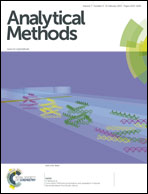A novel micro pressurized liquid extraction method for very rapid solid sample preparation
Abstract
A novel micro pressurized liquid extraction (μPLE) method is introduced, which employs rapid heating in a static mode to remove analytes from 5–10 mg samples in as little as 10 seconds using only 125 μL of solvent. For example, using pharmaceutical tablets and green tea leaves as test samples, 99 ± 5% of acetylsalicylic acid and 97 ± 4% of acetaminophen (both n = 4) were each extracted into methanol from tablets in 10 seconds at 150 °C. For green tea, 100 ± 20% (n = 4) of the caffeine present could be extracted into methanol after only 20 seconds at 275 °C. These extraction results compared very well with those of conventional PLE trials on the same samples, although μPLE was much faster and less solvent intensive. As an application, μPLE was found to extract 101 ± 7% (n = 6) of Fluoxetine Hydrochloride from dried blood spot analysis cards after only 20 seconds at 250 °C. The instrumentation and procedure required for this technique are relatively simple, inexpensive, and can easily be adapted in most laboratories. Overall, the results indicate that μPLE may provide a useful method for rapidly preparing solid samples for analysis using little solvent. The potential advantages and limitations of the method are presented and discussed.


 Please wait while we load your content...
Please wait while we load your content...